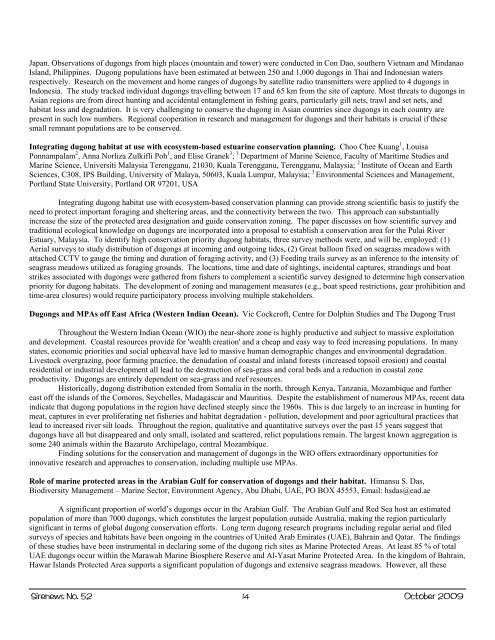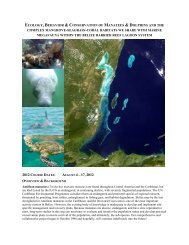Tribute to Dr. Akoi Kouadio - Sirenian International
Tribute to Dr. Akoi Kouadio - Sirenian International
Tribute to Dr. Akoi Kouadio - Sirenian International
Create successful ePaper yourself
Turn your PDF publications into a flip-book with our unique Google optimized e-Paper software.
Japan. Observations of dugongs from high places (mountain and <strong>to</strong>wer) were conducted in Con Dao, southern Vietnam and Mindanao<br />
Island, Philippines. Dugong populations have been estimated at between 250 and 1,000 dugongs in Thai and Indonesian waters<br />
respectively. Research on the movement and home ranges of dugongs by satellite radio transmitters were applied <strong>to</strong> 4 dugongs in<br />
Indonesia. The study tracked individual dugongs travelling between 17 and 65 km from the site of capture. Most threats <strong>to</strong> dugongs in<br />
Asian regions are from direct hunting and accidental entanglement in fishing gears, particularly gill nets, trawl and set nets, and<br />
habitat loss and degradation. It is very challenging <strong>to</strong> conserve the dugong in Asian countries since dugongs in each country are<br />
present in such low numbers. Regional cooperation in research and management for dugongs and their habitats is crucial if these<br />
small remnant populations are <strong>to</strong> be conserved.<br />
Integrating dugong habitat at use with ecosystem-based estuarine conservation planning. Choo Chee Kuang 1 , Louisa<br />
Ponnampalam 2 , Anna Norliza Zulkifli Poh 1 , and Elise Granek 3 ; 1 Department of Marine Science, Faculty of Maritime Studies and<br />
Marine Science, Universiti Malaysia Terengganu, 21030, Kuala Terengganu, Terengganu, Malaysia; 2 Institute of Ocean and Earth<br />
Sciences, C308, IPS Building, University of Malaya, 50603, Kuala Lumpur, Malaysia; 3 Environmental Sciences and Management,<br />
Portland State University, Portland OR 97201, USA<br />
Integrating dugong habitat use with ecosystem-based conservation planning can provide strong scientific basis <strong>to</strong> justify the<br />
need <strong>to</strong> protect important foraging and sheltering areas, and the connectivity between the two. This approach can substantially<br />
increase the size of the protected area designation and guide conservation zoning. The paper discusses on how scientific survey and<br />
traditional ecological knowledge on dugongs are incorporated in<strong>to</strong> a proposal <strong>to</strong> establish a conservation area for the Pulai River<br />
Estuary, Malaysia. To identify high conservation priority dugong habitats, three survey methods were, and will be, employed: (1)<br />
Aerial surveys <strong>to</strong> study distribution of dugongs at incoming and outgoing tides, (2) Great balloon fixed on seagrass meadows with<br />
attached CCTV <strong>to</strong> gauge the timing and duration of foraging activity, and (3) Feeding trails survey as an inference <strong>to</strong> the intensity of<br />
seagrass meadows utilized as foraging grounds. The locations, time and date of sightings, incidental captures, strandings and boat<br />
strikes associated with dugongs were gathered from fishers <strong>to</strong> complement a scientific survey designed <strong>to</strong> determine high conservation<br />
priority for dugong habitats. The development of zoning and management measures (e.g., boat speed restrictions, gear prohibition and<br />
time-area closures) would require participa<strong>to</strong>ry process involving multiple stakeholders.<br />
Dugongs and MPAs off East Africa (Western Indian Ocean). Vic Cockcroft, Centre for Dolphin Studies and The Dugong Trust<br />
Throughout the Western Indian Ocean (WIO) the near-shore zone is highly productive and subject <strong>to</strong> massive exploitation<br />
and development. Coastal resources provide for 'wealth creation' and a cheap and easy way <strong>to</strong> feed increasing populations. In many<br />
states, economic priorities and social upheaval have led <strong>to</strong> massive human demographic changes and environmental degradation.<br />
Lives<strong>to</strong>ck overgrazing, poor farming practice, the denudation of coastal and inland forests (increased <strong>to</strong>psoil erosion) and coastal<br />
residential or industrial development all lead <strong>to</strong> the destruction of sea-grass and coral beds and a reduction in coastal zone<br />
productivity. Dugongs are entirely dependent on sea-grass and reef resources.<br />
His<strong>to</strong>rically, dugong distribution extended from Somalia in the north, through Kenya, Tanzania, Mozambique and further<br />
east off the islands of the Comoros, Seychelles, Madagascar and Mauritius. Despite the establishment of numerous MPAs, recent data<br />
indicate that dugong populations in the region have declined steeply since the 1960s. This is due largely <strong>to</strong> an increase in hunting for<br />
meat, captures in ever proliferating net fisheries and habitat degradation - pollution, development and poor agricultural practices that<br />
lead <strong>to</strong> increased river silt loads. Throughout the region, qualitative and quantitative surveys over the past 15 years suggest that<br />
dugongs have all but disappeared and only small, isolated and scattered, relict populations remain. The largest known aggregation is<br />
some 240 animals within the Bazaru<strong>to</strong> Archipelago, central Mozambique.<br />
Finding solutions for the conservation and management of dugongs in the WIO offers extraordinary opportunities for<br />
innovative research and approaches <strong>to</strong> conservation, including multiple use MPAs.<br />
Role of marine protected areas in the Arabian Gulf for conservation of dugongs and their habitat. Himansu S. Das,<br />
Biodiversity Management – Marine Sec<strong>to</strong>r, Environment Agency, Abu Dhabi, UAE, PO BOX 45553, Email: hsdas@ead.ae<br />
A significant proportion of world’s dugongs occur in the Arabian Gulf. The Arabian Gulf and Red Sea host an estimated<br />
population of more than 7000 dugongs, which constitutes the largest population outside Australia, making the region particularly<br />
significant in terms of global dugong conservation efforts. Long term dugong research programs including regular aerial and filed<br />
surveys of species and habitats have been ongoing in the countries of United Arab Emirates (UAE), Bahrain and Qatar. The findings<br />
of these studies have been instrumental in declaring some of the dugong rich sites as Marine Protected Areas. At least 85 % of <strong>to</strong>tal<br />
UAE dugongs occur within the Marawah Marine Biosphere Reserve and Al-Yasat Marine Protected Area. In the kingdom of Bahrain,<br />
Hawar Islands Protected Area supports a significant population of dugongs and extensive seagrass meadows. However, all these<br />
Sirenews No. 52 14 Oc<strong>to</strong>ber 2009













